Exploring Harlem: Renaissance New York Harlem, Melba's and more things to do

It might have been just another book release party for a young writer’s first novel, but the 1924 dinner held to launch “This is Confusion” ended up instead launching something far greater — the Harlem Renaissance.
The seminal movement in American art, music and letters, which was spearheaded by such African American figures as Langston Hughes, Zora Neale Hurston and Duke Ellington, this year celebrates its 100th anniversary. As such, there’s never been a better time for a long day trip to upper Manhattan's Harlem — or short overnight one — and a glimpse at a neighborhood that remains one of NYC’s most electric cultural, artistic and culinary destinations.
Ready to dive into Harlem’s dynamic past, present and future? Here’s how.
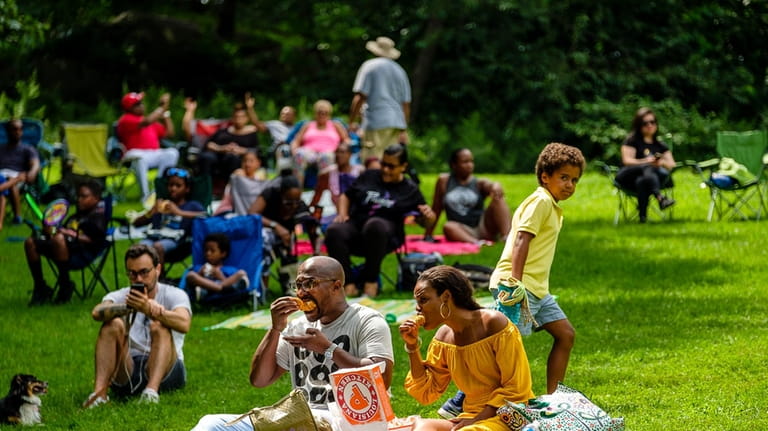
Festival attendees hang on the lawn during the Sundae Sermon, a dance party in tribute to women, at St Nicholas Park in Harlem. Credit: Jeff Bachner
1 p.m. Get the lay of the land with a local
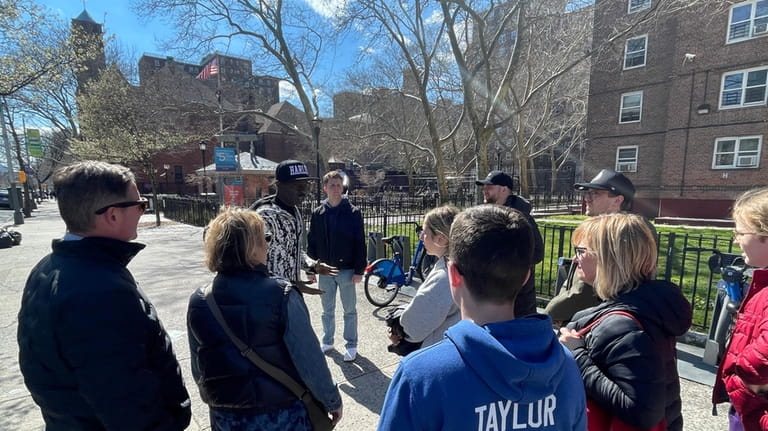
Neal Shoemaker of Harlem Heritage tours leads a group on a Renaissance tour of the neighborhood. Credit: Scott Vogel
Hughes’ poetry was about “workers, roustabouts and singers,” as the writer once put it, “people up today and down tomorrow, working this week and fired the next, beaten and baffled, but determined not to be wholly beaten.” Which is why it’s fitting that Neal Shoemaker should begin his Harlem Heritage walking tours in front of a wall-size photo of Hughes, part of an exhibition at the Schomburg Center for Research in Black Culture on Malcolm X Blvd. Not only is the Harlem native something of a poet who’s been up and down himself, Shoemaker has a genius for bringing the Renaissance’s ebullience and hope — and the terrific pain that came with it — to vivid life. One moment he’s thrilled by the outpouring of music, art and the neighborhood’s anything-goes attitude toward Prohibition--“in Harlem they said don’t hide it, divide it!” — and the next rueful at the Cotton Club’s refusal to hire dancers whose skin was darker than a brown paper bag. He points out the speakeasy where a 17-year-old Billie Holiday was discovered, where Madam C.J. Walker ran the hair care and straightening products company that made her America’s first female millionaire, where the Savoy Ballroom once stood and impromptu Ella Fitzgerald performances were the rule. But Shoemaker never loses sight of the antinomies: the dangers faced by Black people in the segregated South and the relief of stepping off the bus in Harlem, which for some meant cold pavement beneath shoeless feet; all the hopes and dreams that came with the journey North, and the disillusionment of realizing that the journey had just begun. (212-280-7888, harlemheritage.com)
3:30 p.m. A great evening starts with great evening wear
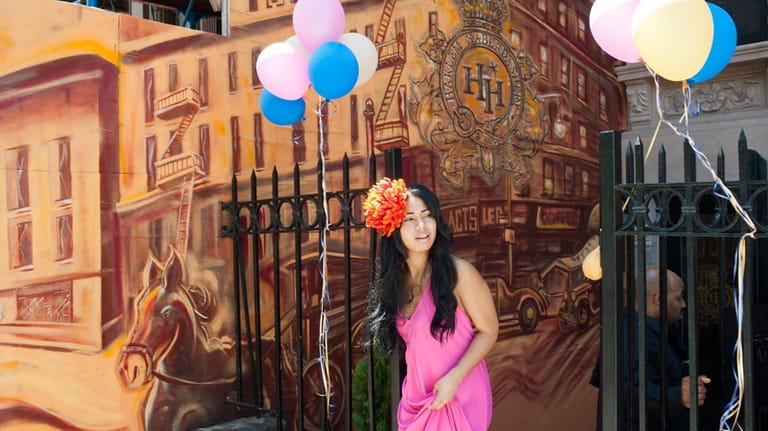
Harlem Haberdashery sells clothing and accessories inspired by the Renaissance “adding a future-forward edge.” Credit: Alamy Stock Photo/Richard Levine / Alamy Stock Photo
Bold choices of color, intricate patterning, a blending of African and Western styles of dress — the period made contributions to the world of fashion too, as evidenced by the clothing company Harlem Haberdashery, which sits just a few blocks from the end of Shoemaker’s tour and whose website notes that it “draws inspiration from the rich cultural history and distinctive style of the Harlem Renaissance while adding a future-forward edge.” The retail arm of 5001 Flavors, which has been dressing celebrities for more than 30 years, Mary J. Blige and Alicia Keys among them, HH’s offerings include high-quality hoodies, hats, denim wear, kimono jackets, eyewear, sneakers and a line of spirits, much of it made at the company’s studio in the Bronx, which boasts seven tailors on staff. If you’re lucky, Louis Johnson Jr., one of the designers and a self-proclaimed accessory king, will be working the day you show up. He’ll happily dress you up for a night on the town, not to mention offer tons of recommendations for where else to shop, eat and play in Harlem. (245 Malcolm X Blvd., 646-707-0070, harlemhaberdashery.com)
5 p.m. Stay at the neighborhood’s newest big thing
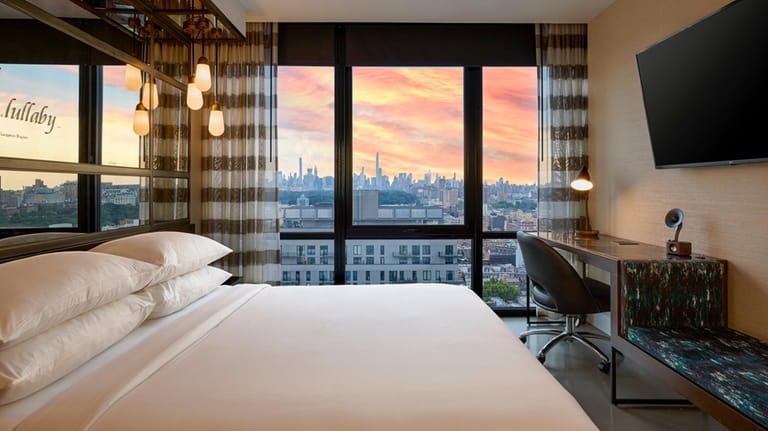
The King Suite at the Renaissance New York Harlem Hotel. Credit: Marriott International
Next, it’s time to check in at the Renaissance New York Harlem hotel, which opened last August and is unmissable for lots of reasons. For one, it occupies the tallest building in the neighborhood — 28 stories — with jaw-droppingly unobstructed views of Central Park and midtown.
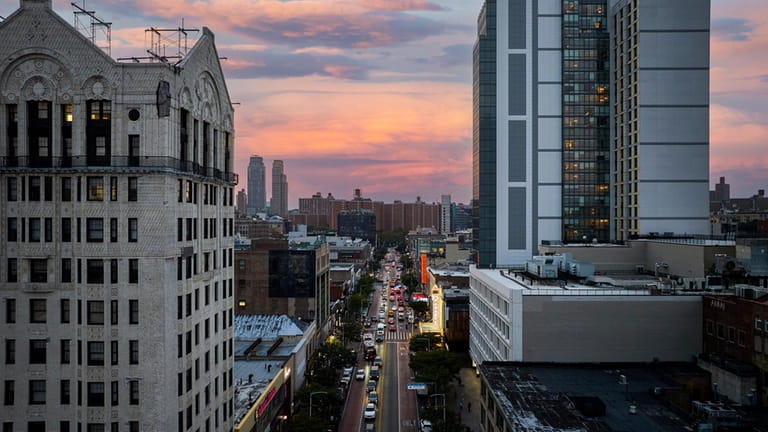
The exterior of Renaissance New York Harlem Hotel. Credit: Marriott International
For another, the 211-room property is perched above the historic Apollo Theater’s new 99- and 199-seat stages, both of which debuted in February as part of a renovation of the old Victoria vaudeville house.
And then there’s the hotel itself, which proudly foregrounds Harlem’s history and culture with an Art Deco-inspired lobby, giant Cab Calloway and Louis Armstrong photos in the elevators, vintage ads for Billie Holiday concerts on pillows in the lobby, and Hughes’ poetry etched into mirrors in its rooms. The latter are cleverly appointed as well, featuring floor-to-ceiling windows that frame glittery scenes of nighttime Gotham. (233 W. 125th St., 332-266-8722, marriott.com)
7 p.m. Dinner in fusion
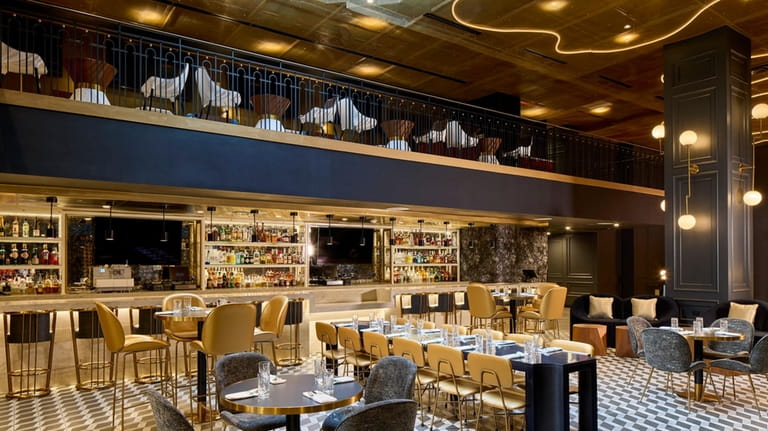
The Lobby Restaurant of the Renaissance New York Harlem Hotel. Credit: Marriott International
There are lots of great places you might eat tonight, but why not go the easy route and dine at the Victoria, a lounge and restaurant in the Renaissance lobby that’s as pretty and smart as the hotel itself? On weekend evenings, when someone’s always tinkling the ivories at an aqua-colored grand piano, the bar stools fill up early with patrons enjoying interesting libations like the Harlem Hurricane (the usual plus mango and yuzu) and the Misty (vodka, aloe vera, mint, cucumber).
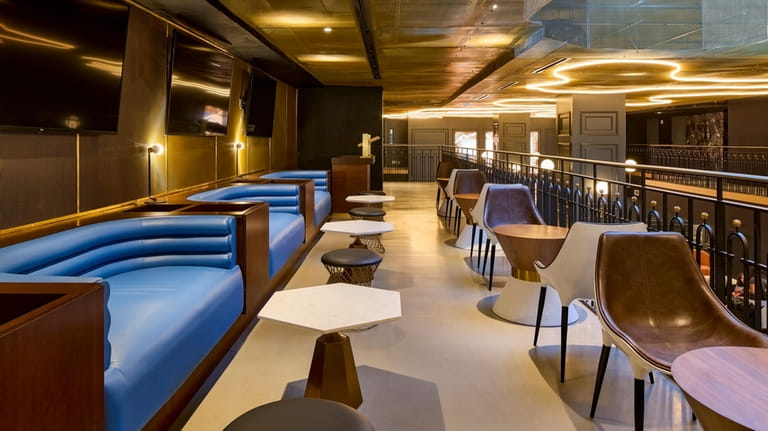
The Mezzanine of the Renaissance New York Harlem Hotel. Credit: Marriott International
The adjacent dining area isn’t large, and its menu isn’t long, but both are cuter than most lobby restaurants, and chef Melvin Johnson’s soul fusion cooking is, in a word, irresistible. Paper-thin shards of fried okra tossed in garam masala make for a perfect snack, as do cups of gumbo or mac ’n cheese with crawfish, although the mains are the real standouts: shrimp and grits with Cajun ham, grilled pork with peach gastrique, and perfectly fried catfish served with hush puppies that for once you’ll actually like.
9 p.m. Swing Street, still swingin’
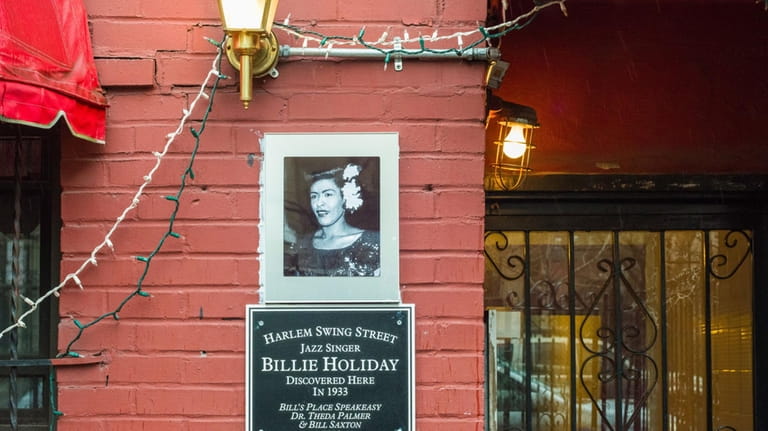
Bill's Place, former speakeasy and jazz venue in Harlem's 'Jungle Alley.' Credit: Alamy Stock Photo/Douglas Lander / Alamy Stock Photo
“You want to hear the kind of stuff they played 80 years ago?” Shoemaker had asked during the tour, pointing to a red awning. Yes, we nodded in unison. “This is where you need to come.” Just a few blocks north of the hotel sits Bill’s Place, a holdover from the days when the block was so loaded with jazz clubs and speak-easies it was known as Swing Street and Jungle Alley, the latter because it was a haven for interracial mingling. A holdover himself who once sold newspapers and shined shoes in the neighborhood, Bill Saxton grew up to be the establishment’s founder and an accomplished saxophonist, and on just two evenings a week — Friday and Saturday, a pair of shows each night — he performs jazz sets with his small ensemble, the Harlem All-Stars. It’s a no-frills scene, no food, BYOB only, and the best seats are always gone early, but rare is the jazz fan who doesn’t leave with a deeper appreciation of that most original of American art forms and the streets that gave rise to it. (148 W. 133rd St., 212-281-0777, billsplaceharlem.com)
8 a.m. It’s morning, time to eat again
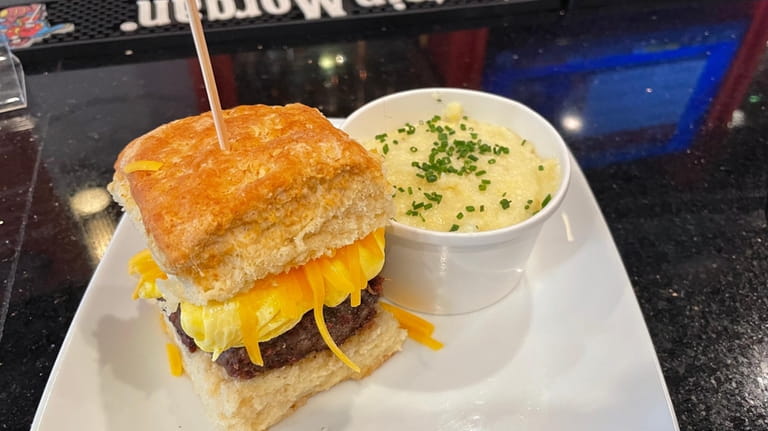
House-made sausage and eggs on a biscuit with a side of grits at the Harlem Biscuit Company. Credit: Scott Vogel
During the pandemic, while some of us were swilling wine and doom-scrolling, Melvin “Boots” Johnson was in his New Rochelle garage working on a biscuit recipe, eventually producing specimens so heavenly he built a whole business around them, the Harlem Biscuit Company. Walk a few blocks up Adam Clayton Powell Blvd from the hotel to this charming breakfast spot, where you’ll be greeted by a bank of kiosks and a host of difficult choices. First, there’s the matter of the biscuit itself — buttermilk? chives and Cheddar? everything seasoning?— and then what goes on it. The John Lewis is popular (very spicy chicken, housemade slaw) as is the Frederick (housemade pork sausage, egg, cheese, jerk honey) but options bordering on the endless include the Ali (goat cheese, egg whites, herb honey) and the Queenie (house-cured salmon and sesame scallion eggs), so many a person could go hungry while scrolling the kiosk. Anyway, whatever you decide, don’t forget to add a side of buttery grits or breakfast potatoes. Both are excellent. (2308 Adam Clayton Powell Jr. Blvd., 929-390-1472, harlembiscuitcompany.com)
10 a.m. Leaving Harlem for a trip to its past
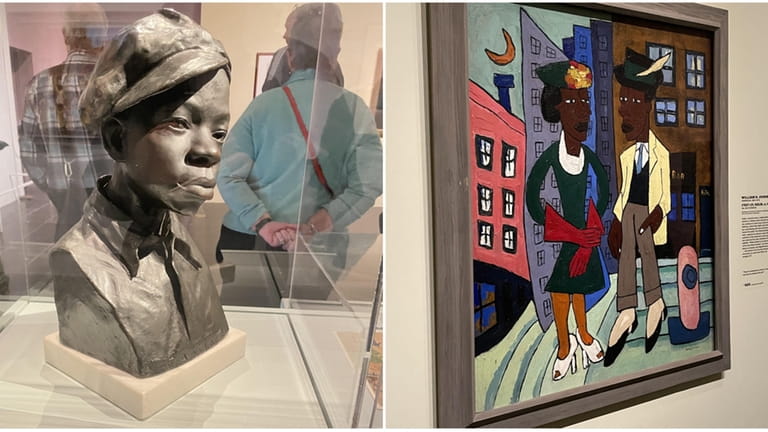
“Gamin,” a sculpture by Augusta Savage, part of an exhibition devoted to the Harlem Renaissance at the Metropolitan Museum of Art; “Street Life, Harlem,” a painting by William H. Johnson, part of an exhibition devoted to the Harlem Renaissance at the Metropolitan Museum of Art. Credit: Scott Vogel
Sometimes you need to leave a place to truly understand it, so once you’re fortified by Johnson’s biscuits, hail a cab for a trip south to the Metropolitan Museum of Art and its well-curated “Harlem Renaissance and trans-Atlantic Modernism” exhibition (through July 28). There may be no better way to grasp the movement than by gazing at works like William H. Johnson’s boldly hued painting of a Harlem couple dressed for a night on the town, Aaron Douglas’ “Aspects of Negro Life” mural foregrounding the excitement of freedom even as hooded Ku Klux Klan figures stain the periphery, Meta Vaux Warrick Fuller’s trenchant sculpture depicting the 1918 lynching of a pregnant black Georgia woman, and silent film clips of Josephine Baker dancing at the Folies-Bergere and Calloway performing “Hi-De-Ho.”

“Carnival,” a painting by Archibald Motley, part of an exhibition devoted to the Harlem Renaissance at the Metropolitan Museum of Art.
But the Renaissance was as much an intellectual movement as an artistic one, and the Met show also spotlights plenty of satirical pieces, journals and works of cultural criticism like Alain Locke’s influential anthology “The New Negro,” even as it explores the Harlem Renaissance’s impact on the larger world, and vice versa. (1000 Fifth Ave., 212-535-7710, metmuseum.org)
1 p.m. Oh, look, it’s time to eat again
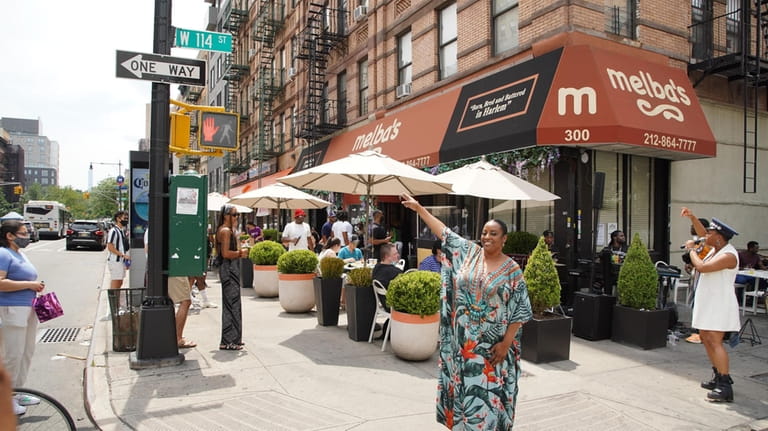
Harlem restaurateur Melba Wilson, chef and owner, poses for a photo outside of Melba’s restaurant during the first Juneteenth Festival in Harlem in June 2021. Credit: Getty Images/Rob Kim
All that gallery perusing can leave even the most devoted museum fan in need of another meal, and this being Harlem you’re never far from one. Head back north and a dazzling lunch courtesy that other queen of Harlem dining, Melba Wilson. Straight-up decadence is a guiding principle at Melba’s, where it’s not enough to serve mouthwatering fried chicken on an eggnog waffle.
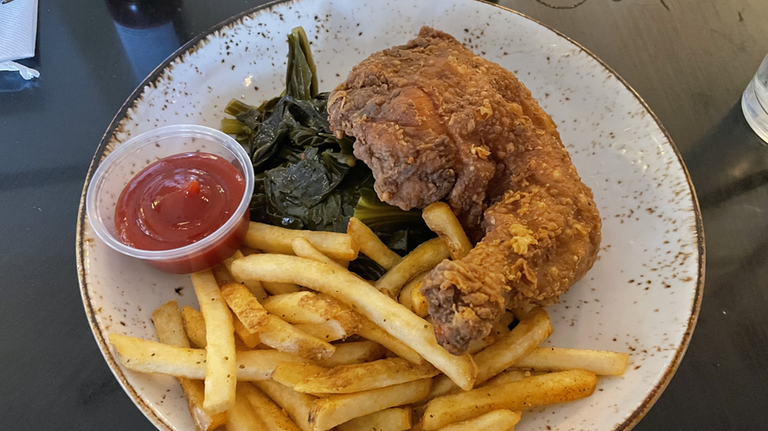
Fried chicken with collard greens at Melba’s, a Harlem restaurant. Credit: Scott Vogel
You have to slather on strawberry butter and a drizzle of maple syrup too. Indeed, no ordinary menu item is ordinary in Wilson’s hands, from the heavenly collard greens to velvety garlic mashed potatoes to grandma’s recipe for sweet potato pie. And a glass of iced tea is mandatory, or rather Harlem Iced Tea, an intoxicating — literally — combo of sweet tea, lemon and Maker’s Mark. (300 W. 114th St., 212-864-7777, melbasrestaurant.com)
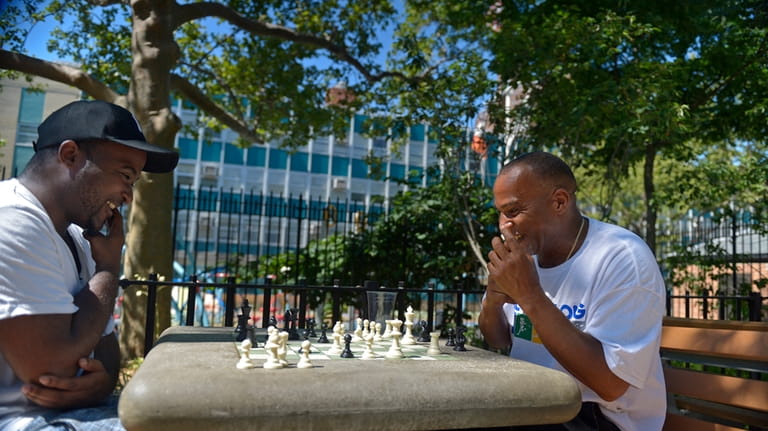
Troy Parks reacts after he lost to his friend Christopher Hartfield at Wright Brothers Playground in Harlem. Credit: Steven Sunshine
3 p.m. Shopping for gifts and souvenirs
As your Harlem odyssey draws to a close, you’ll no doubt want to take home some mementos from the trip, and there are at least two fine places near Melba’s to get them. Exceptionally well curated and beautifully cozy is NiLu (191 Malcolm X Blvd., 646-964-4926, shopnilu.com), which sells everything from candles to coffee table books celebrating the neighborhood. “There weren’t any gift stores in Harlem,” owner Katrina Parris told us of NiLu, which opened in 2015, “and there needed to be a platform for makers of color from Harlem and beyond.”
Malcolm Shabazz Harlem Market, an open air market in the neighborhood of Harlem. Credit: Hemis / Alamy Stock Photo; Frances Roberts / Alamy Stock Photo
Well-made tchotchkes and stylish conversation pieces abound both there and at nearby Malcolm Shabazz Harlem Market (52 W. 116th St., 212-987-8131), a covered outdoor bazaar where vendors from Kenya, Senegal, Mali and other African nations hawk goods from their home countries. Compact but loaded with high-quality, unique items, the market is just the place to pick up authentic textiles, art works and more, everything from jewelry to musical instruments to hand-carved wooden figurines.
6 p.m. Ending the trip with a bang
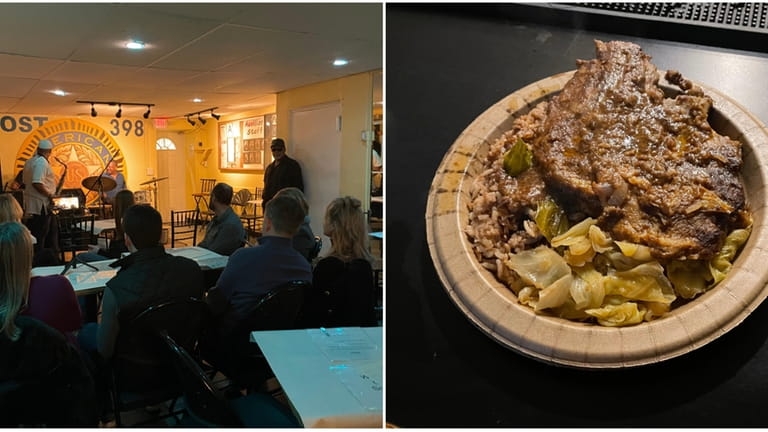
A Sunday afternoon jazz set by the Harlem Groove Band and smothered pork chops at American Legion Post #398. Credit: Scott Vogel
It’s a mile north to your last stop and a block of stately if nondescript Harlem brownstones, a trip that’s worth it for what’s surely the most popular veterans outpost in New York, and maybe anywhere, thanks to a 25-year-old Sunday afternoon tradition at American Legion Post #398. There, jazz aficionados from all over the world find their way to the ground floor and an unmarked door, which leads to a small stage for the Harlem Groove Band, along with a bar and a dozen or so tables, all of them filled during one recent visit with visitors from Houston, San Diego, Zurich … and Siberia. They come for bandleader David Lee Jones’ old-school jazz, to hear magisterial contributions from the hall’s Hammond B-3 organ, for the bargain-priced cocktails and, last but not least, the cheap Sunday suppers. There’s something moving about watching young jazz fans — some barely old enough to drink — bopping along to a world-class saxophonist and drummer while feasting on deeply satisfying plates of smothered pork chops, ribs and fried chicken. Indeed, the whole evening — inspired improvising, blue notes and brio — will bring a smile to even the most world-weary face, effecting a personal renaissance to go along with Harlem’s. (248 W. 132nd St., 212-283-9701)
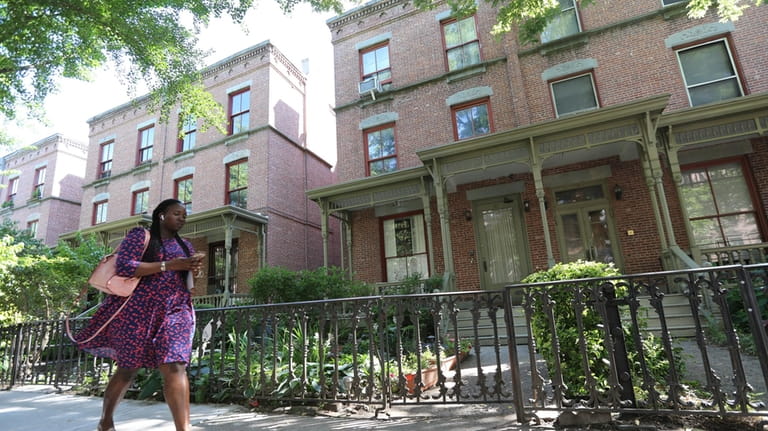
Historic buildings at 130th Street and Lenox Avenue in Harlem. Credit: Linda Rosier

